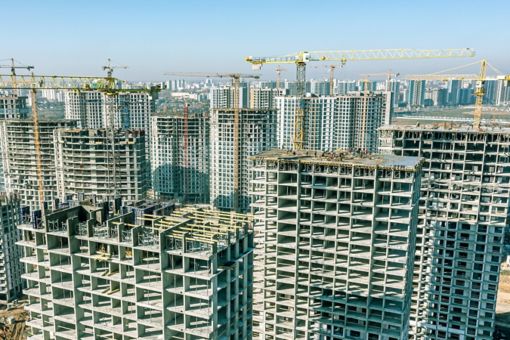Cities contribute significantly to economic growth, accounting for over 80% of global gross domestic product (GDP), however they also produce more than 70% of global greenhouse gas emissions. Goal 11 of the United Nation’s Sustainable Development Goals (SDGs) revolves around “making cities and human settlements inclusive, safe, resilient and sustainable”. As the global population continues to grow, there is a pressing need to construct modern and sustainable cities that can accommodate everyone.
Combining societal and environmental challenges
“When we talk about sustainable cities, we are not just talking about climate and environmental challenges, policy making or the journey to net zero, it is much broader. It is also about the social aspect and how different stakeholders find one another in an urban setting. It is finding a new way of living, working, producing, and consuming, and translating this into a more integrated but sustainable urban planning.” says Veerle Coussée Partner at KPMG Tax, Legal and Accountancy.
“Cities make tangible the societal transition we are facing in climate change, digitalization, aging population and migration. It is where public and private sector, innovators and investors come together and find solutions for the urban environment. Therefore, cities are an opportunity to look at something in a far more integrated way and create new service offerings” adds Jorn Verbeeck, Senior Manager Advisor at KPMG Advisory.
Urban planning is re-shaping markets
To ensure the survival and prosperity of all, we require innovative urban planning that prioritizes safety, affordability, and resilience, while also creating culturally stimulating and environmentally friendly living environments.
“One of the most important tools in achieving sustainable cities is urban planning. What are cities doing with respect to their infrastructure?” asks Veerle “Over the last couple of years, we have seen many local governments in Europe make huge investments not only in infrastructure for electric cars, in preparation for the European Unions’ (EU) 2035 ban on the sale of new CO2 emitting cars, but also in alternative mobility solutions.”
“New European regulations from the EU Green Deal and more traditional instruments like urban planning and taxation are changing the markets of today and the future” says Jorn. “Since the Covid pandemic, there has been big discussions on mobility and commuting, the ways in which we use both home and office spaces, and how to heat and power them in the most efficient way.
“Why is urban planning particularly important? Well, infrastructure, transport, real estate, and utilities today will be around for many decades. So it is important to carefully consider how we design frameworks to facilitate investments in long term solutions, that brings both a return on investment and societal benefits. For this, more cross-sector thinking and cooperation is need, and also better data and complexity management to avoid designing siloed solutions.”
Moving from siloed approaches to integrated solutions
“For a long time, we have been investing in siloed methods” Jorn adds. “However, if we want to achieve the 2050 ambitions that governments and industries have set out, then we need to come to a far more integrated agenda. Meaning more cooperation and co-investment between industrial sectors but also between public and private sector. This requires trust, but also a different approach on how we assess risk, revenues, roles, and responsibilities.”
“The funding for the investment in public infrastructure is of course a crucial element in working towards achieving sustainable cities,” says Veerle. “Tax incentives are often used to shift or drive a certain behavior. However, there is also the tension for governments between granting tax incentives and not jeopardizing or putting more pressure on governments’ budgets. They want to stimulate sustainable investments but on the other hand they need to make sure their tax income remains sufficient, which is a difficult exercise.”
“The speed and scale needed to reach climate neutrality by 2050 is enormous. We are not yet grasping where all the investments required will come from,” says Jorn. “If you look at financial markets, there is still a long debate on what risks are involved without the relevant statistics to back up long term investments in a rapidly changing world. Despite the unknown, the European Green Deal framework, EU taxonomy, the Carbon Border Adjustment Mechanisms (CBAM), Digital Product Passports (DPP), and the Corporate Sustainability Reporting Directive (CSRD) are providing long term direction.”
Increasing pressure from stakeholders
“Increasingly companies are starting to feel the pressure to be sustainable, but also more transparent in their activities and investments. Real estate companies and developers, for example, are forced by regulations to be more sustainable and construct their buildings in a more green and resilient way” says Veerle. “However, it is not only regulatory pressure forcing companies to implement sustainable measures.
“Nowadays, customers no longer want to invest or lease buildings that are not sustainable, flexible or adaptable over time, as they may become stranded assets. Banks and financial institutions are moving towards green financing meaning they only want to invest in companies or buildings which are meeting certain sustainability standards.
“Furthermore, internal stakeholders such as company employees are now requiring their employers to meet certain goals with respect to sustainability so, this is now an aspect helping to attract and retain talent.”
Long-term vision and consistency will be key
“There is no lack of ambition, but leadership, a compelling vision, transparency and an engaging implementation process will be key” says Jorn. “We often miss the long-term picture on what is meant by a net zero future and what is the business and value model that will then be in place knowing that the built environment is one that progresses slowly. We need to spark imagination on what net zero means and how to move beyond compliancy to leverage first-mover advantages.”
“Major infrastructure projects are indeed very long-term investments. Due to their nature, these projects often survive multiple governments,” adds Veerle. “Overtime opinions on best case scenarios but also scientific or technologic insight changes, which can sometimes make it difficult for all involved parties to remain engaged.”
“It is important that we look forward, but we must also look back from the future until today to see what is needed in terms of infrastructure, finance, taxation and make the big decisions on when and how to act, and who really needs to be around the table,” concludes Jorn. “With a long-term policy and investment framework, consistency is imperative. For the speed and scale we need to achieve progress, we cannot change our minds and vision every five years.”
With proper planning and management, urban development can lead to sustainable and prosperous futures for all. We can no longer look at the challenges and solutions for sustainable cities in a siloed manner. Collaboration, open dialogue, and shared investment and risk will be key. Ultimately, we must work together to find an integrated solution if we want to meet global targets and build sustainable cities.
KPMG Smart Cities services
Decarbonizing urban environments, requires addressing many policy challenges and industrial sectors at the same time. A smart city strategy enables a cross-sectoral approach by functionally combining data and future urban scenarios. In the last few years, KPMG’s Business Performance Improvement (BPI) team has helped local and regional government agencies design Smart City (ecosystems) and region strategies to support over 40 cities through the VLAIO City of Things initiative.
Start preparing for your companies’ future today
How does the future look for your organization? Contact one of our experts today and let’s work towards a sustainable future together.
Connect with us
- Find office locations kpmg.findOfficeLocations
- kpmg.emailUs
- Social media @ KPMG kpmg.socialMedia






